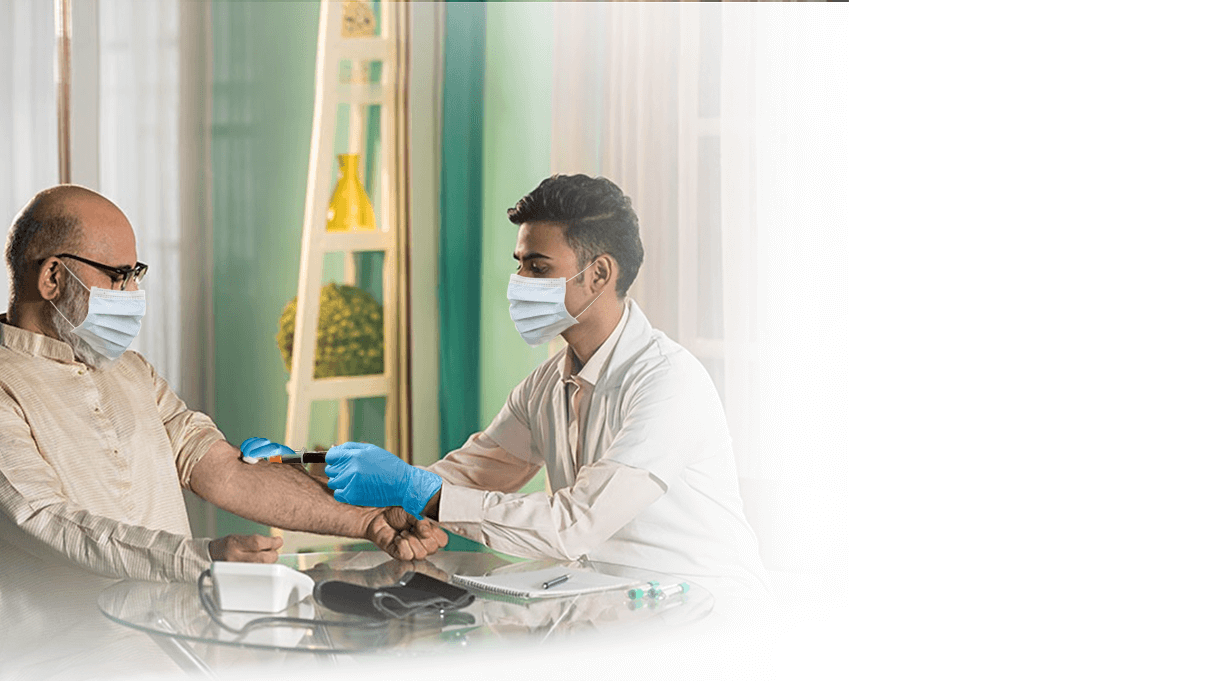Why fevers are common in the rainy season?
During rainy seasons, the rain can bring about various diseases that can cause serious health issues for you and your family members. The risk of getting infected with multiple viruses and other infections is higher in the rainy season because of the high moisture content in the air and stagnant water that enables harmful microorganisms to thrive, eventually resulting in disease transmission. Fevers are conditions where the body's temperature rises in response to the body's immune system.
Common types of fevers in the rainy season
During the rainy season, the transmission of common types of fever occurs through four primary channels: mosquitoes, water, air, and contaminated food.
Mosquito-borne diseases
Mosquito bites introduce viruses and parasites into the bloodstream, causing mosquito-borne diseases that are transmitted through mosquito saliva. These infectious agents can pose a threat to humans, especially when stagnant water provides mosquitoes with ideal breeding conditions during the rainy season.
· Malaria: It is most common during the rainy season. It is caused by a parasite called plasmodium, which enters the body through the bite of an infected Anopheles mosquito that inject malaria parasites into the bloodstream. Early diagnosis is important, as delayed treatment may result in severe health complications like cerebral malaria, renal failure, seizures, and jaundice.
· Chikungunya: It is a viral disease that gets transmitted to humans through mosquitoes infected with the Chikungunya virus. The Aedes albopictus mosquito causes chikungunya, and it breeds in stagnant water. After getting infected, individuals may experience joint and muscular pain for months at a time.
· Dengue: It is also a viral infection transmitted to humans through the Aedes species mosquito. It primarily affects the platelets in the body, and treatments should be started immediately to prevent a drop in the platelet count, which can lead to life-threatening conditions.
Air-Born borne diseases
The rainy season is associated with multiple air-borne diseases such as colds, viral fever, coughs, and sore throats. These diseases are spread through the air by tiny pathogens, are mostly mild, and cause minor infections in adults. Older adults and children are more susceptible to infections during this season due to their low immune systems.
· Influenza: This viral infection is transmissible between individuals and primarily targets the throat, nose, and lungs, leading to respiratory system complications. If left untreated, it can lead to pneumonia and other chronic medical conditions such as asthma, heart disease, and diabetes.
· Cold and flu: It is also a viral infection caused by sudden fluctuations in the weather and temperatures during the rainy season. A weak immune system increases susceptibility to these minor infections. It is accompanied by a running nose, sore throat, watery eyes, fever, and chills.
Water-borne diseases
Waterborne diseases are illnesses that occur due to the presence of microscopic organisms like viruses and bacteria in water that has been contaminated. These diseases can be transmitted through the consumption of contaminated water, as well as through activities such as bathing, washing, and ingesting food prepared with contaminated water.
· Cholera: It is caused by a bacteria called Vibrio cholera. The transmission of the disease primarily takes place through the ingestion of contaminated water or food, giving rise to symptoms like dehydration and diarrhea. Severe cases can lead to electrolyte imbalances, which can cause life-threatening conditions.
· Typhoid fever: It is caused by the bacteria known as Salmonella typhi, which is transmitted through spoilt food and drinking contaminated water.
· Jaundice: It is a condition where the skin, eyes, and mucous membranes (nose and mouth) become yellow. It is due to the buildup of a chemical called bilirubin in the body. Conditions such as gallstones, hepatitis, and tumors can cause jaundice.
Symptoms of fever
Symptoms associated with fever during the rainy season are
· High temperature
· Chills
· Headaches
· Fatigue
· Sweating
· Dizziness
· Rashes on the skin
· Vomiting
· Dehydration
· Difficulty in breathing
· Poor appetite
· Muscle cramps
· Sensitivity to light
· Seizures
Precautions to prevent fevers in the rainy season
· It is necessary to keep your body hydrated. Have herbal teas, water infused with lemon, and soups that help your body get hydrated.
· Eat foods rich in vitamin C, such as lemons, oranges, and guavas.
· Maintain personal hygiene during rainy seasons. Keep your body dry and clean. Bathe twice a day with warm water and use an antiseptic soap to kill bacteria.
· Use mosquito nets, repellant creams, and sprays before sleeping.
· Always wash vegetables and fruits, drink boiled water, cover your food, and avoid consuming outside food.
· Keep your children away from infected people and wash their hands thoroughly once they come home.
Diagnostic test and interpretation of results
The qualitative detection of 8 common monsoon fevers, along with inflammatory markers, is often performed using a double multiplex PCR-based profile by real-time reverse transcriptase-polymerase chain reaction (RT-PCR). This method allows for the identification of:
• Dengue
• Chikungunya
• Malaria
• Typhoid
• Leptospirosis
• West Nile
• Rickettsia
• Zika Fever
• Interleukin-6 (IL-6)
• Complete Blood Count (CBC)
• Complete Urine Examination
Dengue Virus
|
Parameters |
Normal range |
|
RBC count (Male) |
4.7 to 6.1 million cells/mcL |
|
RBC count (Female) |
4.2 to 5.4 million cells/mcL |
|
WBC count |
4,500 to 10,000 cells/mcL |
|
Platelets |
150,000 to 450,000/dL |
|
Hemoglobin (Male) |
13.8 to 17.2 gm/dL |
|
Hemoglobin (Female) |
12.1 to 15.1 gm/dL |
|
IgG & IgM |
<1.64 IV (negative) >2.85 IV (positive) |
Chikungunya Virus
|
Parameters |
Range |
Interpretation |
|
IgG antibody |
0.80 to 1.09 |
Anti-chikungunya antibodies may be present, repeat test in 1-2 weeks |
|
>1.10 |
Anti-chikungunya antibodies are present, indicating past or current infection |
|
|
IgM antibody |
0.80 to 1.09 |
Anti-chikungunya antibodies may be present, repeat test in 1-2 weeks |
|
>1.10 |
Anti-chikungunya antibodies are present, indicating past or current infection |
Malaria
|
Parameters |
Interpretation |
|
Positive |
Indicates that the plasmodium parasite is present in the blood, and you may be infected with malaria. |
|
Negative |
Indicates that the plasmodium parasite is absent in the blood |
Typhoid
|
Parameters |
Interpretation |
|
Positive |
Indicates the presence of Salmonella spp that may cause typhoidal and non-typhoidal infections. |
|
Negative |
Indicates that the infection is not detected in the blood sample. |
Leptospira
|
Parameter |
Gender & Age |
Range |
|
Leptospira antigen |
Unisex – all age groups |
>100kU/I |
West Nile virus
|
Parameters |
Interpretation |
|
Positive |
Indicates the presence of antibodies to West Nile virus with high infection. |
|
Negative |
Indicates that the antibodies to West Nile virus are not detected in the blood sample. |
|
Inconclusive |
Indicates that the test neither confirms nor objects the presence of West Nile virus in blood sample. |
Rickettsia
|
Parameters |
Interpretation |
|
Molecular test -PCR |
Indicates the presence of the rickettsia pathogen, confirms the infection, and the sensitivity may be reduced after antibiotic usage. |
|
Immunofluorescence antibody |
Indicates the presence of antibodies of the pathogen which needs acute and convalescent samples to confirm the disease. |
Zika virus
|
Parameters |
Interpretation |
|
Positive |
Indicates the presence of Zika virus or antibodies to Zika virus in the blood sample. |
|
Negative |
Indicates that the infection is not detected in the blood sample. |
Interleukin-6
|
Parameter (Normal value) |
Interpretation |
|
<7pg/ml (picograms per milliliter)
|
Higher value: Indicates that the person is suffering from an inflammatory condition. Lower value: Confirms the presence of less severe inflammatory response. |
Complete Blood Count (CBC)
|
Parameters |
Normal blood counts |
|
RBC count (Male) |
4.7 to 6.1 million cells/mcL |
|
RBC count (Female) |
4.2 to 5.4 million cells/mcL |
|
WBC count |
4,500 to 10,000 cells/mcL |
|
Hematocrit (Male) |
40.7% to 50.3% |
|
Hematocrit (Female) |
36.1% to 44.3% |
|
Hemoglobin (Male) |
13.8 to 17.2 gm/dL |
|
Hemoglobin (Female) |
12.1 to 15.1 gm/dL |
|
MCV |
80 to 95 femtoliter |
|
MCH |
27 to 31 pg/cell |
|
MCHC |
32 to 36 gm/dL |
|
Platelet count |
150,000 to 450,000/dL |
|
DLC |
4000 to 10000 /mcL |
|
MPV |
7 to 9 femtoliters |
|
Neutrophils |
40% to 60% |
|
Lymphocytes |
20% to 40% |
|
Monocytes |
2% to 8% |
|
Eosinophils |
1% to 4% |
|
Basophils |
0.5% to 1% |
|
Band |
0% to 3% |
Complete Urine Examination
|
Parameters |
Interpretation |
|
Positive |
Abnormal substances such as blood, bacteria, etc. were found in the urine sample. |
|
Negative |
No abnormal substances were found in the urine sample. |
During the rainy season, the chances of contracting multiple viruses and other infections are greater. It is important to maintain good hygiene habits and seek medical advice if you experience any symptoms of fever.


